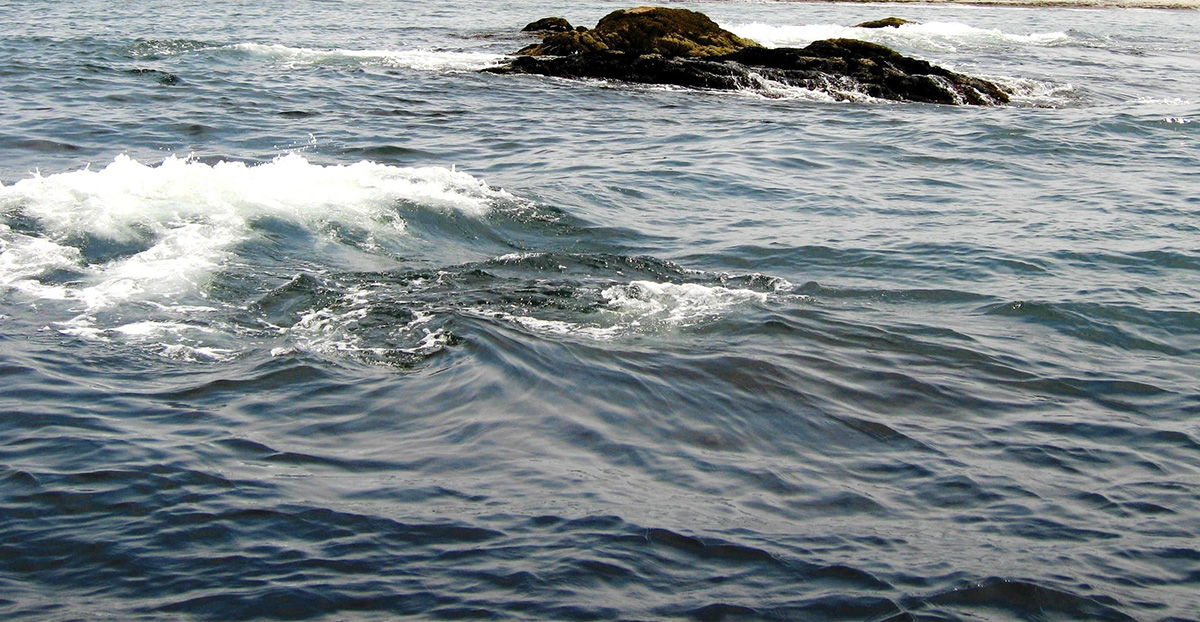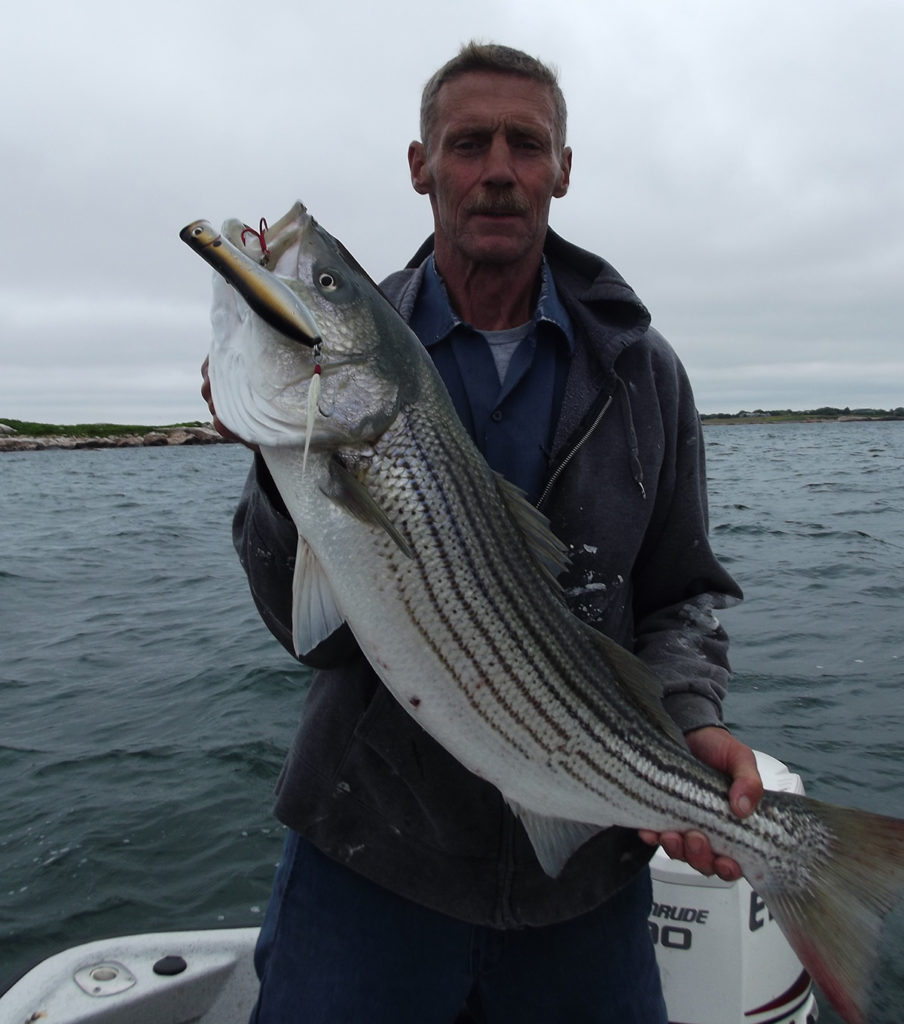
“That was much too easy,” he insisted, but at the time I didn’t know whether I was being complimented or insulted. My Midwestern friend had just landed his first striper, a beautiful 24-pound specimen in the first 15 minutes of our trip. His 40-inch bass was just eight inches short of his best musky, but he was obviously impressed with my ability to put us on quality fish in a short time and said so. The fact that a mere 20-pound-class striper could hang him up in the weeds twice, and nearly abrade his heavy fluorocarbon leader on a submerged boulder, was not entirely lost on the saltwater neophyte.
I don’t recall exactly how I arrived at taking a Great Lakes fisherman out for stripers, but it had something to do with one of my sponsors calling in a favor. My guest was a big man who would never be accused of being shy. From the moment he came aboard he began boasting about being a musky fisherman and just how difficult it was to locate one and get it to take. We were using a few of my Surf Asylum Danny surface swimmers, which he noted were similar in style to the lumber he tossed for his chosen muscular, spotted spike-tooths. Now I’ve seen photos of musky and read about those big northern fish they refer to as freshwater wolves, but I never had any desire to hunt one, much less travel all the way to where they are somewhat plentiful.
I was well aware that catching musky was no easy task, which is why they have been called the fish of 1,000 casts. There was a recent story in one of the national outdoor magazines about a writer who hooked-up with a Wisconsin fishing guide in an effort to determine if he could catch a musky over a long weekend while they counted the actual number of casts he made. I seldom turn down a legitimate fishing challenge, but even if I could catch one in just 500 casts I’d pass on the opportunity.
For my money there is nothing quite like our beloved striped bass. The striper is the all-American fish, a species I wouldn’t trade for any of the “so-called” more glamorous species such as trout, salmon, tarpon or even the prized bonefish, the ghost of the flats. Have you ever tried to eat a bonefish? I have heard old men, many of limited education and vocabulary wax poetic about stripers as a species possessed with human traits of courage and cunning. A few boasted that any fish that was born into and survives that hostile environment then spends most of its life on a continual migratory journey of hundreds of miles each way is the ultimate survivor. As an aside I’ve never heard of anyone hunting muskies for table fare.

Do you know of any other species that is as accessible to anglers from Maine to Florida? At various times during my youth, suffering through the depression brought about during the depths of frigid winter weather, I look back on those boyhood uncertainties. I was worried sick about what would happen to us if that year some natural calamity occurred and the stripers did not return. Occasionally those same reservations have been articulated in the surreptitious fears of my readers.
That was not the case that season. The stripers arrived early that year moving into the herring run behind my house by the third week of April with legal bass taking up residence on the ocean rockpiles by the second week of May. On that morning, the musky man was using a state of the art bait casting outfit with the muscle of an ultra-heavy freshwater bait casting combo. I moved him off the breaker and set up over a usually-productive wash. Based on the previous day’s fishing I expected action but nothing on the order of the ruckus that was waiting for us that morning. On my call, he put his $28 artificial exactly where I pointed and began working it over the wash. The counterfeit wriggled, gurgled and dipped its way over the hump and then was engulfed in an explosion as a bass came up from the side and took it head on. He set up and watched the expensive blue braid peel off his reel like it was being towed by a Jeep. I yelled for him to lock it up to which he responded that he had locked the drag up after his experience with the last fish.
I kicked the boat into gear and moved to change the angle of resistance. That first maneuver was somewhat successful until the striper turned in the direction of the pressure and made a bluefish move, charging the boat. The musky man put all of the reel’s 6.5 gear ratio retrieve to the test, but it wasn’t enough to keep up with the striper, hell bent on running under the boat. I kicked it back into gear to get ahead of the charge, causing the fish to pass safely off the stern. He lumbered aft, wearing a quizzical look. “Do they always act like this?” he questioned. I replied that I’m always prepared for the unexpected because with stripers you just never know.
The fish was now headed back into the jumble of boulders we lured her from, and even the heavy drag wasn’t slowing it down. I suggested that he apply his thumb to the spool because if the bass made it back into that heavy cover it would be home free. He concurred and jammed his thumb down as the rod bent in an almost perfect oval. The maneuver worked and the fish came thrashing to the surface. “How the hell big is that fish?” he inquired. “It doesn’t look much bigger than the first one!” My calculations put that fish at no more than 25 to 28 pounds.
Steady pressure on the taut rod began taking a toll, and the striper’s next run was sideways and much closer to the surface. Two more shorter runs and the fish was alongside, the forward treble on the handsome hunk of wood firmly imbedded in the corner of its boney maw. He handed me his phone to snap a couple of photos before my pliers pried the hook from its jaw. One half-circle at trolling speed flushed enough oxygenated water over her gills to promote strong tail sweeps and permitted the angler to release his grip. He looked up at me, shaking his head and wondered aloud, “That was a wild one.”
I admitted that not all stripers resist in such a fashion and that I have had 30-pounders provide more of a challenge than a 45-pounder. The next two humps produced numerous strikes, follows and slaps but no solid hook-ups and my friend was aghast at my offer to doctor his plug with a shot of Bio-Edge scent. Cheating? No wonder it takes 10,000 casts to catch a musky. At the last wash, I slipped a Surf Asylum Danny doctored with bunker scent alongside a wash and worked it out slowly and deliberately. A boil appeared in its wake at which time I “popped” the lure to simulate an escape and the striper bought it. That was my first cast, and first fish of the morning, and that teen-sized striper seemed to know it was under scrutiny because at the sting of the hooks it took to the air rattling its gills and shaking the plug like an angry tarpon. Needless to say, Mr. Musky was favorably impressed.
After that aerial display and release the sun was high enough to evaporate the dew on the windscreen so my last stop was the edge of a ridge that fell off from 25 to 48 feet. I handed my guest one of Charlie Cinto’s Midnight Black Beauty bucktail jigs and suggested he should walk it down the slope and see if something was willing to eat it. He was agreeable and so was the black sea bass that swallowed the jig because Mr. Musky had just caught me my dinner. An hour or so later, over a late breakfast at the Commons, he articulated his newly-acquired admiration for stripers, at least those he referred to as the most agreeable and pugnacious Newport, Ocean Drive strain.
Throughout a lifetime that spans open seasons on all stripers of at least 16 inches with no daily or seasonal bag limits, to a one-fish a day season, I have never taken stripers for granted. Although I’m always looking for the record striper that I know swims along my bass routes, I never allow size to dictate my efforts. We are all indeed blessed with the prospect of pursuing these magnificent seven-striped fish, and to this my new musky friend—minus the 10,000 cast—is in full agreement.




